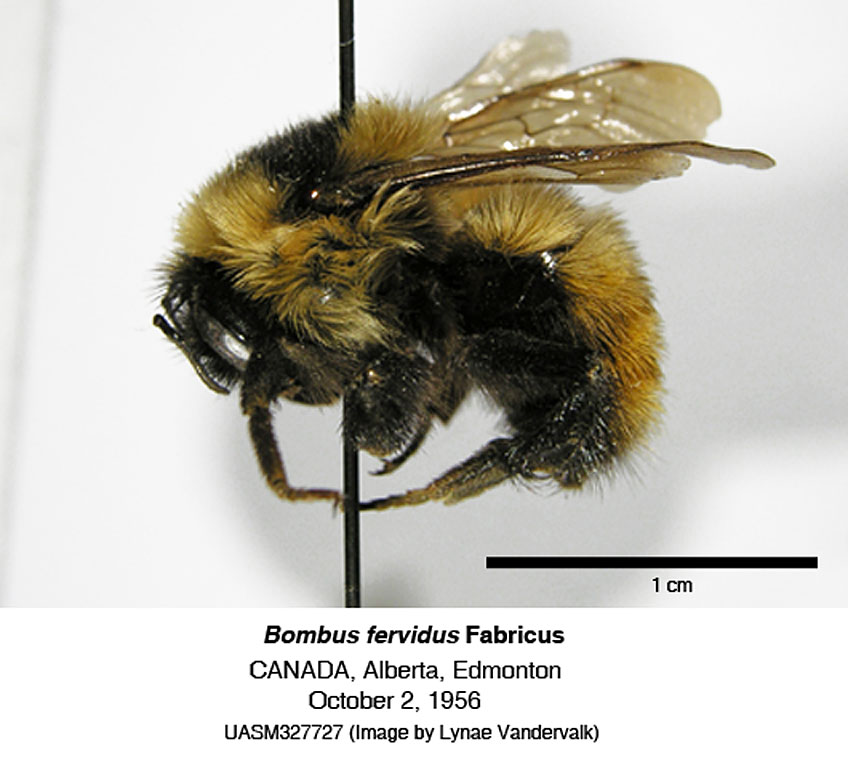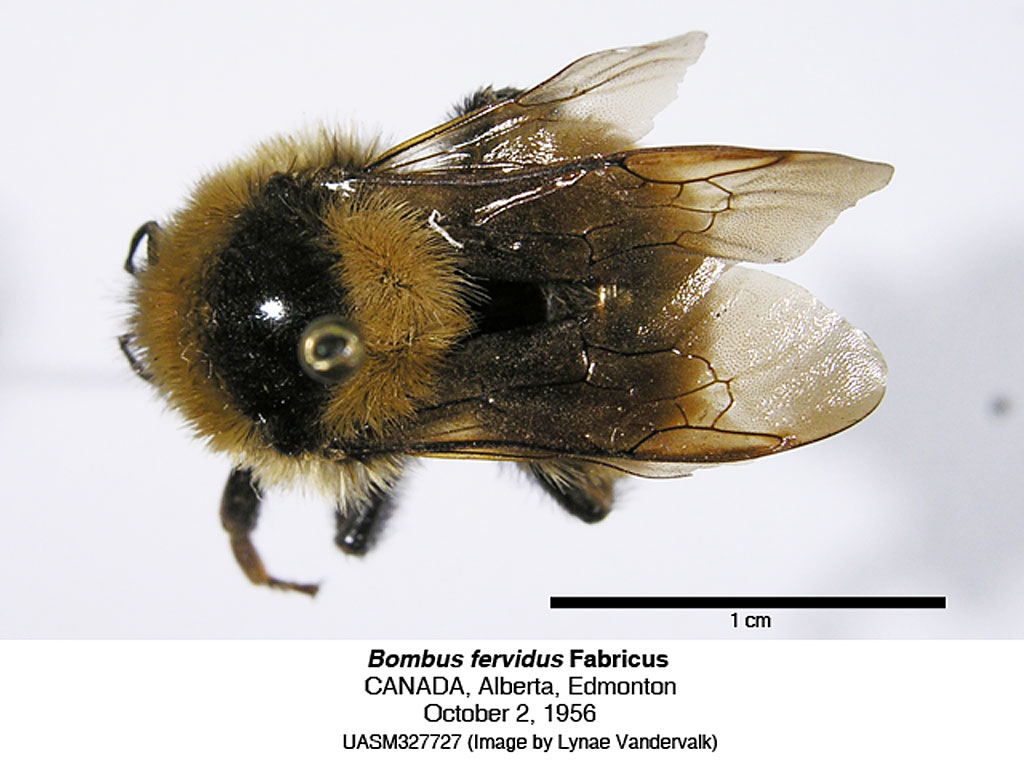Species Details
Bombus fervidus
University of Alberta E.H. Strickland Entomological Museum Read more about this collection »
SeasonalityMales are found flying from early July to early October, workers from early May to late October, and queens from early April to late October (Thorp et al. 1983).
IdentificationFemales of the subgenus Fervidobombus have ocelli onthe supraorbital line, and first flagellomere that are shorter than the second and third flagellomeres combined; males have can be distinguished by first flagellomere that are shorter than the third flagellomere and apically turned penis valves (Thorp et al. 1983). Bombus fervidus males have dorsal abdominal segments 1-5 covered with yellow pile with segment 6 covered with black pile; females have dorsal abdominal segments 1-4 covered with yellow pile while segments 5 and 6 have black pile (Franklin 1912). Female wings are darker stained than males; the malar space of both sexes is one-third the length of the eye (Franklin 1912). Bombus fervidus is easily confused with B. californicus, but can be distinguished by yellow pile on the scutellum, thoracic pleura, and metasomaltergites 1-3, while B. californicus has black pile in these areas (Thorp et al. 1983). Franklin (1912) gives the following morphological indices for castes of B. fervidus. Queens range in length from 15 mm to 21 mm; wing spread from 37 mm to 41 mm; and width of second abdominal segment from 8.5 mm to 10.5 mm. Workers vary in length from 8 mm to 15 mm; wing spread from 17 mm to 35 mm; and width of second abdominal segment from 3.5 mm to 8 mm. Length of males ranges from 10 mm to 16 mm; wing spread from 25 mm to 33 mm; and width of second abdominal segment from 6 mm to 8 mm.
Scientific Name
Bombus fervidus
Habitat
Commonly found in prairie habitats with considerable adaptability in nesting location (Hobbs 1966).
Seasonality
Males are found flying from early July to early October, workers from early May to late October, and queens from early April to late October (Thorp et al. 1983).
Identification
Females of the subgenus Fervidobombus have ocelli onthe supraorbital line, and first flagellomere that are shorter than the second and third flagellomeres combined; males have can be distinguished by first flagellomere…
Females of the subgenus Fervidobombus have ocelli onthe supraorbital line, and first flagellomere that are shorter than the second and third flagellomeres combined; males have can be distinguished by first flagellomere that are shorter than the third flagellomere and apically turned penis valves (Thorp et al. 1983). Bombus fervidus males have dorsal abdominal segments 1-5 covered with yellow pile with segment 6 covered with black pile; females have dorsal abdominal segments 1-4 covered with yellow pile while segments 5 and 6 have black pile (Franklin 1912). Female wings are darker stained than males; the malar space of both sexes is one-third the length of the eye (Franklin 1912). Bombus fervidus is easily confused with B. californicus, but can be distinguished by yellow pile on the scutellum, thoracic pleura, and metasomaltergites 1-3, while B. californicus has black pile in these areas (Thorp et al. 1983). Franklin (1912) gives the following morphological indices for castes of B. fervidus. Queens range in length from 15 mm to 21 mm; wing spread from 37 mm to 41 mm; and width of second abdominal segment from 8.5 mm to 10.5 mm. Workers vary in length from 8 mm to 15 mm; wing spread from 17 mm to 35 mm; and width of second abdominal segment from 3.5 mm to 8 mm. Length of males ranges from 10 mm to 16 mm; wing spread from 25 mm to 33 mm; and width of second abdominal segment from 6 mm to 8 mm.
Life History
Alford (1975) outlines the life history of Bombus fervidus. Newly mated B. fervidus queens overwinter beneath the soil litter and emerge from their hibernacula in late spring. Queens are transitory for a time, growing…
Alford (1975) outlines the life history of Bombus fervidus. Newly mated B. fervidus queens overwinter beneath the soil litter and emerge from their hibernacula in late spring. Queens are transitory for a time, growing in size while collecting pollen and looking for a suitable nest. Once a suitable nest has been found, the queen constructs an apple sized hollow structure within it. The queen deposits her eggs within a mound of pollen on the floor of the structure; she also constructs a honeypot for storing nectar. Newly hatched larvae begin consuming the pollen mound, requiring the queen to continue provisioning it. The queen periodically incubates her brood by sitting upon it and respiring to generate body heat. The larvae spin cocoons in the final instars, as do the pupa; the cocoons may be re-used later for storage of pollen or nectar. Upon pupation, the emerged adults take nectar from the honey pot. Once the nest consists of the new young workers and the queen it can be considered a social unit and is referred to as a colony. Subsequent generations are produced differently from the first: new eggs are laid in clumps in cells atop the pupating first generation of workers, and workers are now responsible for provisioning of the growing larva and the honey pot. The caste differentiation of each generation varies throughout the year, with the first generations containing all workers, followed by a worker/male split, followed by mostly males, followed by a male/queen split, followed by mostly queens. The factor initiating queen production has not been established but it appears the colony must reach a size capable of maintaining nest temperatures and food stores before queens are produced. Young queens remain in the colony and will mate during their first week. Males leave the hive and do not return; they establish a methodical flight path and mate with encountered queens. Only the newly mated queens will overwinter in hibernacula; males, founder queens, and all workers perish.
Bombus fervidus queens required an average 27 days to produce the first generation of workers, and summer colonies consisted of an average 247 individuals (Hobbs 1966).
Conservation
Of concern, populations appear to be in decline (Colla and Packer 2008).
Diet Info
Bombus fervidus has been recorded in California foraging on 15 plant families with 34 genera, with the largest proportion being Leguminosae and Compositae (Thorp et al. 1983).
Range
Western, southern and eastern neartic regions (Williams 1998).
Notes
Hobbs (1966) reported nest parasitism by Bombus insularis and queen attacks by conopid flies. Brood may be attacked by Brachicoma sarcophagina flies, and B. fervidus workers have been observed repelling predators from…
Hobbs (1966) reported nest parasitism by Bombus insularis and queen attacks by conopid flies. Brood may be attacked by Brachicoma sarcophagina flies, and B. fervidus workers have been observed repelling predators from nest by regurgitating honey on them, thus impeding further movement and forcing retreat (Alford, 1975).
References
Author
Williams, P. H.
Title
An annotated checklist of bumble bees with an analysis of patterns of description (Hymenoptera: Apidae, Bombini).
Publication Date
1998
Series Title
Bulletin of the British Museum (Natural History) Entomology
Volume
67
Pages
79-152
Author
Thorp, R. W., D. S. Horning Jr. and L. L. Dunning
Title
Bumble bees and cuckoo bumble bees of California (Hymenoptera: Apidae).
Publication Date
1983
Series Title
Bulletin of the California Insect Survey
Volume
23
Pages
viii + 79 pp.
Author
Alford, D. V.
Title
Bumblebees.
Publication Date
1975
Pages
352
Author
Hobbs G. A.
Title
Ecology of species of Bombus Latr. (Hymenoptera, Apidae) in southern Alberta. V. Subgenus Subterramobombus Vogt.
Publication Date
1966
Series Title
The Canadian Entomologist
Volume
98
Pages
288-294
Author
Colla, S.R., Packer, L.
Title
Evidence for decline in eastern North American bumblebees (Hymenoptera: Apidea), with special focus on Bombus affinis Cresson.
Publication Date
2008
Series Title
Biodiversity and Conservation
Volume
17
Pages
1379-1391
Author
Franklin H. J.
Title
The Bombidae of the New World, part I.
Publication Date
1912
Series Title
Transactions of the American Entomological Society
Volume
38
Pages
177– 486
Specimen Information
There are 20 specimens of this Species.
UASM327726 - Bombus fervidus
University of Alberta E.H. Strickland Entomological Museum
Place CollectedCanada: Alberta, Scandia
Collected ByLilly, C. E.
Date Collected1950-08-30
UASM327727 - Bombus fervidus
University of Alberta E.H. Strickland Entomological Museum
Place CollectedCanada: Alberta, Edmonton
Collected BySlabyj, B. M.
Date Collected1956-10-02
UASM327728 - Bombus fervidus
University of Alberta E.H. Strickland Entomological Museum
Place CollectedCanada: Alberta, Golden Spike
Collected ByHocking, B.
Date Collected1957-07-11
UASM327729 - Bombus fervidus
University of Alberta E.H. Strickland Entomological Museum
Place CollectedCanada: Alberta, Lethbridge
Date Collected1947-08-26
UASM327730 - Bombus fervidus
University of Alberta E.H. Strickland Entomological Museum
Place CollectedCanada: Nova Scotia, Smiths Cove
Date Collected1956-05-17
UASM327731 - Bombus fervidus
University of Alberta E.H. Strickland Entomological Museum
Place CollectedCanada: Nova Scotia, Truro
Date Collected1924-08-03
UASM327732 - Bombus fervidus
University of Alberta E.H. Strickland Entomological Museum
Place CollectedCanada: Nova Scotia, Truro
Date Collected1923-08-12
UASM327733 - Bombus fervidus
University of Alberta E.H. Strickland Entomological Museum
Place CollectedCanada: Nova Scotia, Truro
Date Collected1923-08-13
UASM327734 - Bombus fervidus
University of Alberta E.H. Strickland Entomological Museum
Place CollectedCanada: Nova Scotia, Truro
Date Collected1923-08-13
UASM327735 - Bombus fervidus
University of Alberta E.H. Strickland Entomological Museum
Place CollectedCanada: Nova Scotia, Truro
Date Collected1923-08-13
UASM327736 - Bombus fervidus
University of Alberta E.H. Strickland Entomological Museum
Place CollectedCanada: Nova Scotia, Truro
Date Collected1923-08-12
UASM327737 - Bombus fervidus
University of Alberta E.H. Strickland Entomological Museum
Place CollectedCanada: Nova Scotia, Truro
Date Collected1923-08-12
UASM327738 - Bombus fervidus
University of Alberta E.H. Strickland Entomological Museum
Place CollectedCanada: Nova Scotia, Truro
Date Collected1923-08-12
UASM340362 - Bombus fervidus
University of Alberta E.H. Strickland Entomological Museum
Place CollectedCanada: Ontario, Windsor
Collected ByAnweiler, G. G.
Date Collected2013-07-07
UASM340364 - Bombus fervidus
University of Alberta E.H. Strickland Entomological Museum
Place CollectedCanada: Alberta, Dillberry Lake Provincial Park, Dillberry Lake
Collected ByAnweiler, G. G.
Date Collected2013-07-17
UASM340365 - Bombus fervidus
University of Alberta E.H. Strickland Entomological Museum
Place CollectedCanada: Alberta, Dillberry Lake Provincial Park, Dillberry Lake
Collected ByAnweiler, G. G.
Date Collected2013-07-18
UASM372293 - Bombus fervidus
University of Alberta E.H. Strickland Entomological Museum
Place CollectedCanada: Alberta, Warner
Collected BySturm, A.; Kohler, M.
Date Collected2015-06-18
UASM372294 - Bombus fervidus
University of Alberta E.H. Strickland Entomological Museum
Place CollectedCanada: Alberta, Duchess
Collected BySturm, A.; Kohler, M.
Date Collected2014-07-19
UASM372295 - Bombus fervidus
University of Alberta E.H. Strickland Entomological Museum
Place CollectedCanada: Alberta, Kleskun Hill
Collected BySturm, A.; Kohler, M.
Date Collected2014-07-29
UASM372296 - Bombus fervidus
University of Alberta E.H. Strickland Entomological Museum
Place CollectedCanada: Alberta, Warner
Collected BySturm, A.; Kohler, M.
Date Collected2014-07-02



